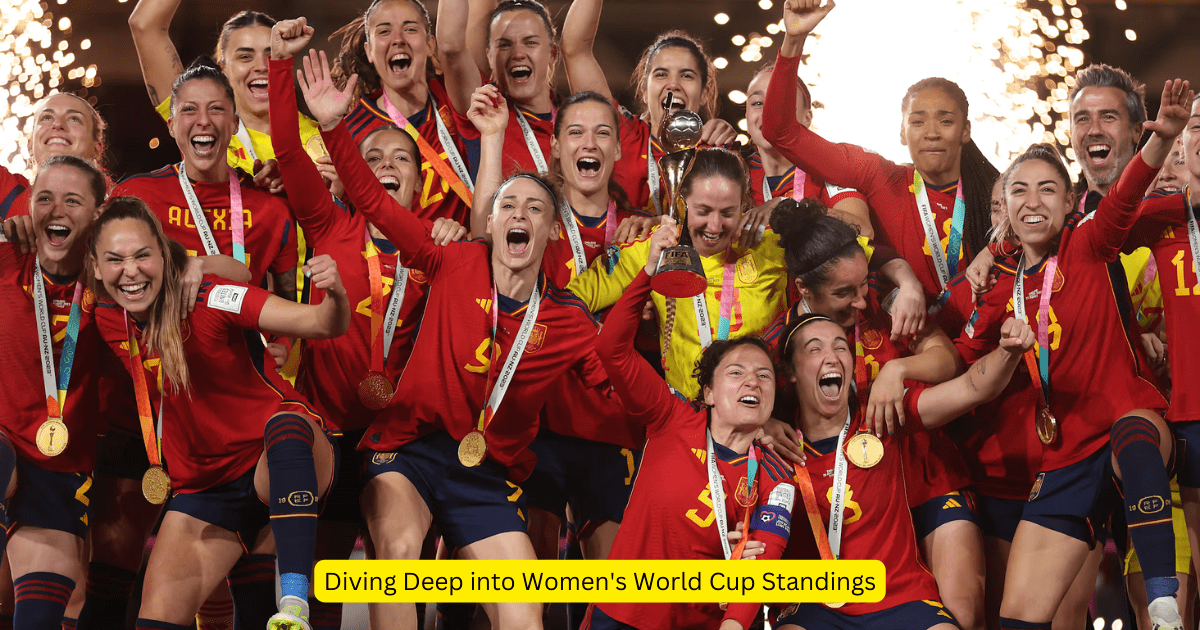The Women’s World Cup (FIFA) is a spectacle unlike any other. It’s a tournament where the world’s best female footballers come together to battle it out for national glory. Every four years, fans across the globe are glued to their screens, cheering on their favorites and witnessing moments of magic etched in sporting history.
But amidst the whirlwind of emotions and breathtaking goals, a crucial element often goes unnoticed: the Women’s World Cup standings. These seemingly simple tables hold immense power, dictating the course of the tournament and revealing the narratives that unfold on the pitch.
The Women’s World Cup is an international association football competition contested by the senior women’s national teams of the members of the Fédération International de Football Association, the sport’s international governing body.
So, let’s delve deeper into the captivating world of Women’s World Cup standings. We’ll explore how they work, their significance, and the stories they tell. Buckle up, because we’re in for an exciting ride!
Also read: https://headlineocean.com/unveiling-the-icc-umpire-salary-the-price-of-fair-play/

Understanding the Women’s World Cup Standings
The Women’s World Cup standings, often referred to as the group tables during the initial stages, function similarly to their counterparts in most football tournaments. Each team within a group is ranked based on a points system. Here’s a breakdown of how points are awarded:
- Three points for a win
- One point for a draw
- Zero points for a loss
The team with the most points at the end of the group stage claims the top spot. In the case of a tie on points, additional factors like goal difference (the difference between goals scored and conceded) and head-to-head record (result of the match between the tied teams) come into play to determine the final ranking.
Why Women’s World Cup Standings Matter
Now, you might be wondering, why are these standings so important? Well, they serve several crucial purposes:
- Tournament Progression: The Women’s World Cup standings dictate which teams advance to the knockout stages. Typically, the top two teams from each group progress, setting the stage for thrilling knockout matches.
- Seeding: Women’s World Cup standings also play a role in seeding teams for the knockout stages. Teams that finish higher in their groups generally get a perceived easier opponent in the first round of the knockout phase. This creates a sense of reward for strong performances throughout the group stage.
- Narrative Building: The Women’s World Cup standings are dynamic and constantly evolving. As teams win, lose, and draw, the tables shift, creating narratives of dominance, surprise upsets, and nail-biting battles for qualification. These narratives add a layer of drama and excitement to the tournament.
- Team Strategies: Women’s World Cup standings can influence team strategies. Depending on their position in the group, teams might adopt a more cautious or attacking approach in their remaining matches. This tactical maneuvering adds another layer of intrigue to the beautiful game.
Also read: Archie Schiller: The Youngest Caption Of the Australian National Team
Examples of How Women’s World Cup Standings Tell Stories
Let’s take a trip down memory lane and revisit some iconic moments in Women’s World Cup history where the standings played a pivotal role:
- The 1991 USA Cinderella Story: The inaugural Women’s World Cup in 1991 saw a classic underdog tale unfold. The United States, ranked lower than several European powerhouses, defied expectations by topping their group. This strong showing propelled them on a historic run to the championship, etching their names in Women’s World Cup folklore.
- The Group of Death in 2015: The 2015 edition of the tournament witnessed a particularly competitive group stage. Group E, dubbed the “Group of Death,” housed powerhouses like Germany, USA, Sweden, and Nigeria. The standings in this group were constantly in flux, with each match holding immense weight. Ultimately, Germany emerged victorious, but the group stage was a captivating display of tactical brilliance and fighting spirit.
- The Drama of 2019: The 2019 Women’s World Cup offered another example of the dramatic potential of the standings. In Group B, Spain and China were locked in a tense battle for the second qualifying spot. Both teams finished on the same points, forcing a tiebreaker based on goal difference. Spain edged out China by a single goal, highlighting the significance of every strike on the pitch.

The Human Element Woven Within the Standings (8th time: Women’s World Cup Standings)
The Women’s World Cup standings, though crucial, are just a snapshot of on-field performances. While they tell the story of points and positions, the true magic lies in the human element that breathes life into those numbers.
Upsets and Underdogs: Standings can be dramatically altered by an underdog’s triumph. Imagine a lower-ranked team battling their hearts out against a group favorite. A surprise victory throws the standings into disarray, injecting excitement and proving that anything is possible on the world stage. The underdog’s resilience and tactical brilliance shine through, inspiring fans and reminding us that passion can sometimes trump rankings.
Redemption Arcs: Sometimes, teams have a point to prove. Maybe they underperformed in the previous World Cup or suffered a heartbreaking loss. Their journey through the group stage becomes a narrative of redemption. Every win propels them up the standings, signifying a team on a mission. This human element adds a layer of emotional investment, making us root for these teams as they rewrite their stories.
Individual Brilliance: The artistry of individual players can define a team’s trajectory in the standings. A striker’s scoring streak, a goalkeeper’s heroic saves, or a midfielder’s tactical genius can propel a team to the top. These moments of individual brilliance are etched in our memories, adding another dimension to the drama of the standings. We see players transcend their role on the chart, becoming heroes who shape the tournament’s narrative.
Leadership and Camaraderie: A team’s cohesiveness and leadership can be a game-changer. A captain who rallies her troops, a coach who inspires tactical innovation – these elements are often reflected in the standings. We witness leadership moments that translate into victories, pushing the team up the table. The camaraderie and fighting spirit within a team, even when faced with adversity, is a testament to the human spirit that transcends the cold calculations of the standings.
The Road to Glory Isn’t Always Linear: The beauty of the Women’s World Cup standings lies in their fluidity. A team might start strong, dominate their initial matches, and sit comfortably at the top. However, a surprise loss or a string of draws can see them tumble down. This rollercoaster ride keeps fans on the edge of their seats, reminding us that even the best teams have to claw their way to glory.
The Women’s World Cup standings, while mathematically sound, offer a glimpse into the heart and soul of the tournament. They are a canvas upon which players paint stories of resilience, passion, and unwavering determination. So, the next time you glance at the standings, remember the human narratives woven within those numbers – they are a testament to the unwavering spirit of the beautiful game.

